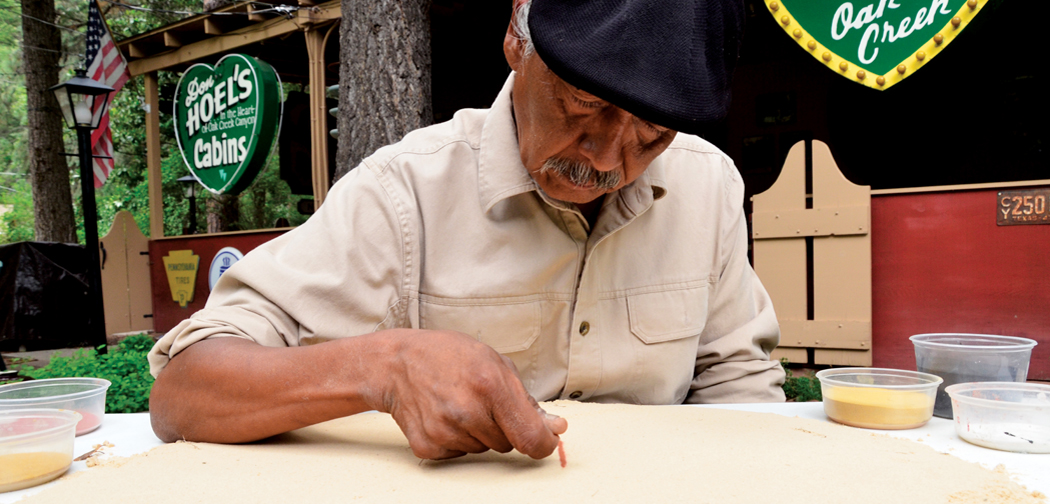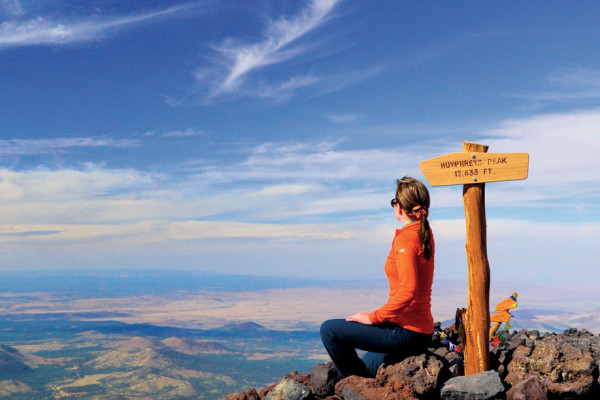Sedona Monthly’s 7th annual cover story featuring Native American artists focuses on Navajo sandpainters. A fairly recent art form, sandpainting was traditionally used by medicine men in religious ceremonies until enterprising artists began using the medium to create contemporary art. Meet Eugene Baatsoslanii Joe, who literally wrote the book on sandpainting, and Joe Ben Jr., who says his legacy is his son, 17-year-old budding artist Zachariah Ben.
Eugene Baatsoslanii Joe
Eugene Baatsoslanii Joe’s favorite quote, the mantra that he lives by, comes from Albert Einstein: “Imagination is more important than knowledge.” It was imagination that fueled Eugene’s interest in art. Born and raised on the Navajo Reservation in Shiprock, N.M., Eugene’s family was involved in traditional ceremonies, and Eugene remembers being curious about sandpainting – or dry painting as it was called at the time – from an early age. He entered boarding school in 1957, and after coming upon a drawing of a stallion, Eugene decided to pursue art. “My intuition was beginning to develop, and I knew I could do this,” he says.
According to Eugene, sandpainting as an art form didn’t begin until midcentury when a Navajo by the name of Fred Stevens purchased a sandpainting kit from a trading post in Gallup. Eugene’s father, James C. Joe, started experimenting with sandpainting in 1962. Two years later, Eugene began to apprentice with his father. “It was mostly about discipline,” says Eugene, wearing a chunky turquoise necklace and jeans and sipping a bottle of water. “I swept a lot of floors, but I also learned about figures and designs.” Sandpaintings used in religious ceremonies are usually limited to only a handful of pigments, but James wasn’t satisfied with that. He and his son began traveling the country, collecting pigments for their artwork. Eugene estimates that they collected more than 200 unique colors over the years. “We collected so much sand when we were on the road,” he says, laughing.
Other members of Eugene’s family took up the art form, and they traveled all over the Southwest, demonstrating sandpainting in museums and at trading posts. But the family couldn’t escape controversy when a group of medicine men began to question James Joe’s subject matter, which was increasingly secular and had begun to deviate from Navajo tradition. Eugene says one of his own early paintings featured Shiprock’s namesake rock formation. He created landscapes, portraits and still lifes with sand. “I’m partially Pueblo Indian, so my designs have always been unusual and incorporated different images,” he says.
Eugene struck up a friendship with artist Donald Esley from Maine in the mid-1970s, and Don taught him about shading and creating three-dimensional effects in his paintings. Eugene says Don’s philosophy was that an artist should master his work; the work should not master the artist. For decades, Eugene struggled with finding a balance between work and play, particularly in the 1980s when Native American art was at its height of popularity. At that point, he was on a first-name basis with celebrity collectors including Johnny Cash and Robert Redford, who Eugene says was one of his best clients. When he was younger, Eugene painted with his dad daily. The duo created a 4-by-8-foot tabletop that is now on display at Colorado Mesa University in Grand Junction. Eugene couldn’t keep up with the demand for his work, and he was careful about which trading posts and galleries he worked with. At one point, a friend said he had seen Eugene’s work at a gallery in Hong Kong. Things began to slow down in the 1990s; Eugene says he gave his last floor-painting demonstration in 1991. James Joe died in 2000 when he was 90.




